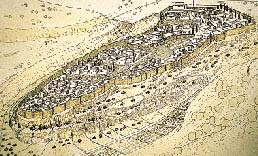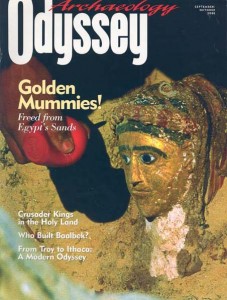Era by Era: The Temple Mount
Sidebar to: When Crusader Kings Ruled Jerusalem

In the 14th century B.C. Jerusalem was important enough to be mentioned in the Amarna Letters, the diplomatic correspondence of the Egyptian pharaohs Amenophis III and his son Akhenaten with other Near Eastern rulers. According to the Bible, David captured Jerusalem around 1000 B.C., renamed it the City of David, and made it the Israelite capital. He later built an altar to the Israelite god Yahweh above the city on Mt. Moriah (in Jewish tradition, this was “the land of Moriah” where God commanded Abraham to sacrifice his son Isaac [Genesis 22:2]). David’s son Solomon extended the city walls to encompass Mt. Moriah (see drawing above). With the assistance of Phoenician artisans from Tyre, in modern Lebanon, Solomon built the First Temple near David’s altar to house the Ark of the Covenant. For 350 years Solomon’s Temple was the focus of Israelite religion—the central place where sacrifices were offered to Yahweh and the major Israelite pilgrimage site. In 586 B.C. the Babylonians under Nebuchadnezzar conquered Jerusalem, took its population into slavery and destroyed the First Temple.
Already a library member? Log in here.
Institution user? Log in with your IP address.

